Achievements and Perspectives on Fe-Based Shape Memory Alloys for Rehabilitation of Reinforced Concrete Bridges: An Overview
Abstract
1. Introduction
2. Classification, Martensite Transformation, and Development of Fe-SMAs
2.1. Classification of Fe-SMAs
2.2. Martensite Transformation of Fe-Mn-Si Alloys
2.2.1. Martensite Transformation
2.2.2. Thermodynamic Mechanism of γ → ε Martensite Transformation
2.2.3. Crystallographic Features of γ → ε Martensite Transformation
2.3. Development of Fe-Mn-Si Alloys
3. Reinforcement Mechanism of RC Bridges with Fe-SMAs
4. Reinforcement Techniques of RC Bridges with Fe-SMAs
4.1. Summary of Reinforcement Techniques
4.2. Reinforcement Method with Anchorage
4.3. Reinforcement Method without Anchorage
5. Reinforcement Applications of RC Beams with Fe-SMAs
5.1. Application on Reinforcement of Small-Scale Specimens
5.2. Application on Reinforcement of Full-Scale Beams
5.2.1. Flexural Performance
5.2.2. Shear Performance
5.2.3. Other Performances
6. Prospects of Future Development
- (1)
- Fe-SMAs have not yet been widely accepted by the market, because their cost is higher than other reinforcement materials, such as CFRP, which is mainly caused by a backward production process. Therefore, improving the manufacturing technology of Fe-SMAs is meaningful to reduce the cost and promote their applications in civil engineering.
- (2)
- Compared with other SMAs, the good weldability of Fe-SMAs is a significant advantage in civil engineering applications, which can greatly reduce the cost of connection. However, previous studies are very limited to investigate the weldability of Fe-SMAs. Therefore, developing weldability, including welding methods and processes, of Fe-SMAs with dissimilar alloys, especially constructional steels, is worth considering.
- (3)
- Fe-SMAs as reinforcement materials are subjected to the humid and variable environments, even corrosive conditions (sea water, chemical waste liquid, etc.). Improving the corrosion resistance of Fe-SMAs should be highlighted, especially for the rehabilitation of bridges.
- (4)
- Bridges constantly undergo the traffic load in service life; hence, the shrinkage and creep of concrete inevitably occur due to the varying of temperature or humidity, resulting in prestress loss of Fe-SMAs. Therefore, the prestress loss should be considered in the design stage.
- (5)
- Most studies in the field of reinforcement by Fe-SMAs have mainly focused on the component level, but few studies concern the application of in-service bridges that are undergoing multi-factor effects, such as cyclic loads, elevated temperatures, and corrosive environments. In the future, applying Fe-SMAs to strengthen the existing deteriorative structures may be a promising research direction.
7. Conclusions
- (1)
- Fe-SMAs represented by Fe-Mn-Si alloys have the advantages of low cost, wide thermal hysteresis, excellent SME, and high elastic modulus, which guarantee great potential for their application in civil engineering.
- (2)
- The SME of Fe-Mn-Si alloys is caused by the γ → ε martensite transformation and its reverse transformation can produce huge recovery stress (400~500 MPa) which can be used as prestress in reinforcement.
- (3)
- Activation methods of Fe-SMAs are varied, including thermal resistance heating, climate chamber heating, flexible tape heating, infrared radiation heating, heat gun heating, flame heating, inductive coil heating, electric furnace heating, autoclave heating, and so on. However, resistance heating is the most widely used activation method in the application, especially in civil engineering.
- (4)
- NSM Fe-SMA technique is the most common method to strengthen RC beams and can effectively protect Fe-SMA strips from damage. Moreover, embedding ribbed Fe-SMA bars in the shotcrete layer is another promising method.
- (5)
- The strengthening of RC beams with Fe-SMAs has achieved great application effect on flexural performance, shear performance, fatigue performance, durability, etc., hence it deserves to be promoted worldwide in the rehabilitation of RC bridges in the near future, especially under the global goal of carbon neutrality.
Author Contributions
Funding
Institutional Review Board Statement
Informed Consent Statement
Data Availability Statement
Conflicts of Interest
References
- Hosseini, A.; Michels, J.; Izadi, M.; Ghafoori, E. A Comparative Study between Fe-SMA and CFRP Reinforcements for Prestressed Strengthening of Metallic Structures. Constr. Build. Mater. 2019, 226, 976–992. [Google Scholar] [CrossRef]
- Czaderski, C.; Shahverdi, M.; Brönnimann, R.; Leinenbach, C.; Motavalli, M. Feasibility of Iron-Based Shape Memory Alloy Strips for Prestressed Strengthening of Concrete Structures. Constr. Build. Mater. 2014, 56, 94–105. [Google Scholar] [CrossRef]
- Cladera, A.; Montoya-Coronado, L.A.; Ruiz-Pinilla, J.G.; Ribas, C. Shear Strengthening of Slender Reinforced Concrete T-Shaped Beams Using Iron-Based Shape Memory Alloy Strips. Eng. Struct. 2020, 221, 111018. [Google Scholar] [CrossRef]
- Schranz, B.; Czaderski, C.; Vogel, T.; Shahverdi, M. Bond Investigations of Prestressed, near-Surface-Mounted, Ribbed Memory-Steel Bars with Full Bond Length. Mater. Des. 2020, 196, 109145. [Google Scholar] [CrossRef]
- Schranz, B.; Czaderski, C.; Vogel, T.; Shahverdi, M. Bond Behaviour of Ribbed Near-Surface-Mounted Iron-Based Shape Memory Alloy Bars with Short Bond Lengths. Mater. Des. 2020, 191, 108647. [Google Scholar] [CrossRef]
- Michels, J.; Shahverdi, M.; Czaderski, C. Flexural Strengthening of Structural Concrete with Iron-Based Shape Memory Alloy Strips. Struct. Concr. 2018, 19, 876–891. [Google Scholar] [CrossRef]
- Ghafoori, E. Editorial for Special Issue on Sustainable Metallic Structures. Eng. Struct. 2019, 183, 83. [Google Scholar] [CrossRef]
- Hariri, N.G.; Almadani, I.K.; Osman, I.S. A State-of-the-Art Self-Cleaning System Using Thermomechanical Effect in Shape Memory Alloy for Smart Photovoltaic Applications. Materials 2022, 15, 5704. [Google Scholar] [CrossRef]
- Rogowski, J.; Kotynia, R. Comparison of Prestressing Methods with CFRP and SMA Materials in Flexurally Strengthened RC Members. Materials 2022, 15, 1231. [Google Scholar] [CrossRef]
- Huang, W.M.; Ding, Z.; Wang, C.C.; Wei, J.; Zhao, Y.; Purnawali, H. Shape Memory Materials. Mater. Today 2001, 13, 54–61. [Google Scholar] [CrossRef]
- Da Silva Teixeira, R.; de Oliveira, R.V.; Rodrigues, P.F.; Mascarenhas, J.; Neves, F.C.F.P.; dos Santos Paula, A. Microwave versus Conventional Sintering of NiTi Alloys Processed by Mechanical Alloying. Materials 2022, 15, 5506. [Google Scholar] [CrossRef] [PubMed]
- Carreira, P.; Gatões, D.; Alves, N.; Ramos, A.S.; Vieira, M.T. Searching New Solutions for NiTi Sensors through Indirect Additive Manufacturing. Materials 2022, 15, 5007. [Google Scholar] [CrossRef] [PubMed]
- Otsuka, K. Science and Technology of Shape-Memory Alloys: New Developments. MRS Bull. 2002, 27, 91–100. [Google Scholar] [CrossRef]
- Buehler, W.J.; Gilfrich, J.V.; Wiley, R.C. Effect of Low-Temperature Phase Changes on the Mechanical Properties of Alloys near Composition TiNi. J. Appl. Phys. 1963, 34, 1475–1477. [Google Scholar] [CrossRef]
- Zhu, L.; Liu, Y.; Li, M.; Lu, X.; Zhu, X. Calculation Model of Mechanical and Sealing Properties of NiTi Alloy Corrugated Gaskets under Shape Memory Effect and Hyperelastic Coupling: Two Sealing Properties. Materials 2022, 15, 4659. [Google Scholar] [CrossRef]
- Yang, H.; Yan, W.; Deng, X.; Zhang, M.; Wang, Y. Improving the Shape Memory Effect of a Fe-Mn-Si-Cr-Ni Alloy through Shot Peening. Materials 2022, 15, 2585. [Google Scholar] [CrossRef]
- Mantovani, D. Shape Memory Alloys: Properties and Biomedical Applications. JOM 2000, 52, 36–44. [Google Scholar] [CrossRef]
- Otsuka, K.; Ren, X. Physical Metallurgy of Ti–Ni-Based Shape Memory Alloys. Prog. Mater. Sci. 2005, 50, 511–678. [Google Scholar] [CrossRef]
- Mohd Jani, J.; Leary, M.; Subic, A.; Gibson, M.A. A Review of Shape Memory Alloy Research, Applications and Opportunities. Mater. Des. 2014, 56, 1078–1113. [Google Scholar] [CrossRef]
- Branco, M.; Gonçalves, A.; Guerreiro, L.; Ferreira, J. Cyclic Behavior of Composite Timber-Masonry Wall in Quasi-Dynamic Conditions Reinforced with Superelastic Damper. Constr. Build. Mater. 2014, 52, 166–176. [Google Scholar] [CrossRef]
- DesRoches, R.; McCormick, J.; Delemont, M. Cyclic Properties of Superelastic Shape Memory Alloy Wires and Bars. J. Struct. Eng. 2004, 130, 38–46. [Google Scholar] [CrossRef]
- Cladera, A.; Weber, B.; Leinenbach, C.; Czaderski, C.; Shahverdi, M.; Motavalli, M. Iron-Based Shape Memory Alloys for Civil Engineering Structures: An Overview. Constr. Build. Mater. 2014, 63, 281–293. [Google Scholar] [CrossRef]
- Ölander, A. An Electrochemical Investigation of Solid Cadmium-Gold Alloys. J. Am. Chem. Soc. 1932, 54, 3819–3833. [Google Scholar] [CrossRef]
- Saunders, N.; Miodownik, A.P. The Cu-Sn (Copper-Tin) System. Bull. Alloy. Phase Diagr. 1990, 11, 278–287. [Google Scholar] [CrossRef]
- Otsuka, K.; Wayman, K.M. Shape Memory Materials; Cambridge University Press: Cambridge, UK, 1998. [Google Scholar]
- Auricchio, F. Shape Memory Alloys: Applications, Micromechanics, Macromodelling and Numerical Simulations. Ph.D. Thesis, University of California at Berkeley, Berkeley, CA, USA, 1995. [Google Scholar]
- Araki, Y.; Endo, T.; Omori, T.; Sutou, Y.; Koetaka, Y.; Kainuma, R.; Ishida, K. Potential of Superelastic Cu–Al–Mn Alloy Bars for Seismic Applications. Earthq. Eng. Struct. Dyn. 2011, 40, 107–115. [Google Scholar] [CrossRef]
- Czaderski, C.; Hahnebach, B.; Motavalli, M. RC Beam with Variable Stiffness and Strength. Constr. Build. Mater. 2006, 20, 824–833. [Google Scholar] [CrossRef]
- Tiwari, N.D.; Gogoi, A.; Hazra, B.; Wang, Q. A Shape Memory Alloy-Tuned Mass Damper Inerter System for Passive Control of Linked-SDOF Structural Systems under Seismic Excitation. J. Sound Vib. 2021, 494, 115893. [Google Scholar] [CrossRef]
- Sato, A.; Chishima, E.; Soma, K.; Mori, T. Shape Memory Effect in γ Transformation in Fe-30Mn-1Si Alloy Single Crystals. Acta Metall. 1982, 30, 1177–1183. [Google Scholar] [CrossRef]
- Zhou, L. Research of Fe-Mn-Si Based Shape Memory Alloy and Its Coupler. Master’s Thesis, Fuzhou University, Fuzhou, China, 2004. [Google Scholar]
- Soroushian, P.; Ostowari, K.; Nossoni, A.; Chowdhury, H. Repair and Strengthening of Concrete Structures through Application of Corrective Posttensioning Forces with Shape Memory Alloys. Transp. Res. Rec. 2001, 1770, 20–26. [Google Scholar] [CrossRef]
- Lei, Z. Fe-based Shape-memory Alloy and its Applications. Dev. Appl. Mater. 2000, 15, 40–45. [Google Scholar] [CrossRef]
- Janke, L.; Czaderski, C.; Motavalli, M.; Ruth, J. Applications of Shape Memory Alloys in Civil Engineering Structures—Overview, Limits and New Ideas. Mater. Struct. Constr. 2005, 38, 578–592. [Google Scholar] [CrossRef]
- Alam, M.S.; Youssef, M.A.; Nehdi, M. Utilizing Shape Memory Alloys to Enhance the Performance and Safety of Civil Infrastructure: A Review. Can. J. Civ. Eng. 2007, 34, 1075–1086. [Google Scholar] [CrossRef]
- Debbarma, S.R.; Saha, S. Review of Shape Memory Alloys Applications in Civil Structures, and Analysis for Its Potential as Reinforcement in Concrete Flexural Members. Int. J. Civ. Struct. Eng. 2012, 2, 915. [Google Scholar] [CrossRef][Green Version]
- Zhang, Z.X.; Zhang, J.; Wu, H.; Ji, Y.; Kumar, D.D. Iron-Based Shape Memory Alloys in Construction: Research, Applications and Opportunities. Materials 2022, 15, 1723. [Google Scholar] [CrossRef] [PubMed]
- Yusoff, M.; Hamid, N.H.A.; Arshad, M.F.; Arshad, A.K.; Ridzuan, A.R.M.; Awang, H. Self-Healing Shape-Memory Alloy (SMA) in Reinforced Concrete Structures: A Review; Springer: Singapore, 2016. [Google Scholar]
- Zerbe, L.; Reda, M.; Dawood, M.; Belarbi, A.; Senouci, A.; Gencturk, B.; Alansari, M.; Michels, J. Behavior of Retrofitted Concrete Members Using Iron-Based Shape Memory Alloys. In Proceedings of the Fourth Conference on Smart Monitoring, Assessment and Rehabilitation of Civil Structures, Zurich, Switzerland, 13–15 September 2017. [Google Scholar]
- Wayman, C.M. On Memory Effects Related to Martensitic Transformations and Observations in β-Brass and Fe3Pt. Scr. Metall. 1971, 5, 489–492. [Google Scholar] [CrossRef]
- Sohmura, T.; Oshima, R.; Fujita, F.E. Thermoelastic FCC-FCT Martensitic Transformation in Fe-Pd Alloy. Scr. Metall. 1980, 14, 855–856. [Google Scholar] [CrossRef]
- Oshima, R.; Sugiyama, M.; Fujita, F.E. Tweed Structures Associated with Fcc-Fct Transformations in Fe-Pd Alloys. Metall. Trans. A 1988, 19, 803–810. [Google Scholar] [CrossRef]
- Kajiwara, S.; Liu, D.; Kikuchi, T.; Shinya, N. Remarkable Improvement of Shape Memory Effect in Fe-Mn-Si Based Shape Memory Alloys by Producing NbC Precipitates. Scr. Mater. 2001, 44, 2809–2814. [Google Scholar] [CrossRef]
- Sato, A.; Chishima, E.; Yamaji, Y.; Mori, T. Orientation and Composition Dependencies of Shape Memory Effect IN Fe-Mn-Si Alloys. Acta Metall. 1984, 32, 539–547. [Google Scholar] [CrossRef]
- Sato, A.; Yamaji, Y.; Mori, T. Physical Properties Controlling Shape Memory Effect in Fe Mn Si Alloys. Acta Metall. 1986, 34, 287–294. [Google Scholar] [CrossRef]
- Fu, H.; Zhao, H.; Zhang, Y.; Xie, J. Enhancement of Superelasticity in Fe-Ni-Co-Based Shape Memory Alloys by Microstructure and Texture Control. Procedia Eng. 2017, 207, 1505–1510. [Google Scholar] [CrossRef]
- Sobrero, C.; Lauhoff, C.; Langenkämper, D.; Somsen, C.; Eggeler, G.; Chumlyakov, Y.I.; Niendorf, T.; Krooß, P. Impact of Test Temperature on Functional Degradation in Fe-Ni-Co-Al-Ta Shape Memory Alloy Single Crystals. Mater. Lett. 2021, 291, 129430. [Google Scholar] [CrossRef]
- Omori, T.; Ando, K.; Okano, M.; Xu, X.; Tanaka, Y.; Ohnuma, I.; Kainuma, R.; Ishida, K. Superelastic Effect in Polycrystalline Ferrous Alloys. Science 2011, 333, 68–71. [Google Scholar] [CrossRef] [PubMed]
- Omori, T.; Nagasako, M.; Okano, M.; Endo, K.; Kainuma, R. Microstructure and Martensitic Transformation in the Fe-Mn-Al-Ni Shape Memory Alloy with B2-Type Coherent Fine Particles. Appl. Phys. Lett. 2012, 101, 231907. [Google Scholar] [CrossRef]
- Zou, Q.; Dang, S.; Li, Y.; Wang, M. Research Progress of Iron-based Shape Memory Alloys: A Review. Mater. Rep. 2019, 33, 3955–3962. [Google Scholar]
- Xiao, F.; Fukuda, T.; Kakeshita, T.; Takahashi, K. Concentration Dependence of FCC to FCT Martensitic Transformation in Fe–Pd Alloys. J. Alloys Compd. 2013, 577, S323–S326. [Google Scholar] [CrossRef]
- Sakamoto, T.; Fukuda, T.; Kakeshita, T.; Takeuchi, T.; Kishio, K. Magnetic Field-Induced Strain in Iron-Based Ferromagnetic Shape Memory Alloys. J. Appl. Phys. 2003, 93, 8647–8649. [Google Scholar] [CrossRef]
- Xiao, F.; Fukuda, T.; Kakeshita, T. On the Physical Nature of High Reversible Strain in Fe-Pd Single Crystals Exhibiting Lattice Softening. Acta Mater. 2013, 61, 4044–4052. [Google Scholar] [CrossRef]
- Cui, J.; Shield, T.W.; James, R.D. Phase Transformation and Magnetic Anisotropy of an Iron-Palladium Ferromagnetic Shape-Memory Alloy. Acta Mater. 2004, 52, 35–47. [Google Scholar] [CrossRef]
- Ojha, A.; Sehitoglu, H. Transformation Stress Modeling in New Fe-Mn-Al-Ni Shape Memory Alloy. Int. J. Plast. 2016, 86, 93–111. [Google Scholar] [CrossRef]
- Peng, H.; Huang, P.; Zhou, T.; Wang, S.; Wen, Y. Reverse Shape Memory Effect Related to α→γ Transformation in a Fe-Mn-Al-Ni Shape Memory Alloy. Metall. Mater. Trans. A Phys. Metall. Mater. Sci. 2017, 48, 2132–2139. [Google Scholar] [CrossRef]
- Maki, T.; Kobayashi, K.; Minato, M.; Tamura, I. Thermoelastic Martensite in an Ausaged Fe-Ni-Ti-Co Alloy. Scr. Metall. 1984, 18, 1105–1109. [Google Scholar] [CrossRef]
- Cesari, E.; Chernenko, V.A.; Kokorin, V.V.; Pons, J.; Seguí, C. Physical Properties of Fe-Co-Ni-Ti Alloy in the Vicinity of Martensitic Transformation. Scr. Mater. 1999, 40, 341–345. [Google Scholar] [CrossRef]
- Jin, X.; Jin, M.; Geng, Y. Recent Development of Martensitic Transformation in Ferrous Shape Memory Alloys. Mater. China 2011, 56, 32–41. [Google Scholar]
- Tanaka, Y.; Himuro, Y.; Kainuma, R.; Sutou, Y.; Omori, T.; Ishida, K. Ferrous Polycrystalline Shape-Memory Alloy Showing Huge Superelasticity. Science 2010, 327, 1488–1490. [Google Scholar] [CrossRef] [PubMed]
- La Roca, P.; Baruj, A.; Sobrero, C.E.; Malarría, J.A.; Sade, M. Nanoprecipitation Effects on Phase Stability of Fe-Mn-Al-Ni Alloys. J. Alloys Compd. 2017, 708, 422–427. [Google Scholar] [CrossRef]
- Enami, K.; Nagasawa, A.; Nenno, S. Reversible Shape Memory Effect in Fe-Base Alloys. Scr. Metall. 1975, 9, 941–948. [Google Scholar] [CrossRef]
- Choi, E.; Ostadrahimi, A.; Kim, W.J.; Seo, J. Prestressing Effect of Embedded Fe-Based SMA Wire on the Flexural Behavior of Mortar Beams. Eng. Struct. 2021, 227, 111472. [Google Scholar] [CrossRef]
- Kainuma, R.; Imano, Y.; Ito, W.; Sutou, Y.; Morito, H.; Okamoto, S.; Kitakami, O.; Oikawa, K.; Fujita, A.; Kanomata, T.; et al. Magnetic-Field-Induced Shape Recovery by Reverse Phase Transformation. Nature 2006, 439, 957–960. [Google Scholar] [CrossRef]
- Hsu, T.Y. Perspective in Development of Shape Memory Materials Associated with Martensitic Transformation. J. Mater. Sci. Technol. 1994, 10, 107–110. [Google Scholar] [CrossRef]
- Zhou, X.F. Study on the Shape Memory Effect and Property of Fe-Mn-Si-Based Alloy. Master’s Thesis, Wuhan University of Technology, Wuhan, China, 2006. (In Chinese). [Google Scholar] [CrossRef]
- Li, L.; Hsu, T.Y. Gibbs Free Energy Evaluation of the Fcc(γ) and Hcp(ε) Phases in Fe-Mn-Si Alloys. Calphad 1997, 21, 443–448. [Google Scholar] [CrossRef]
- Jin, X.; Xu, Z.; Hsu, T.Y.; Lin, L. Critical Driving Force for Martensitic Transformation Fcc(γ)→hcp(ε) in Fe−Mn−Si Shape Memory Alloys. Sci. China Ser. E Technol. Sci. 1999, 42, 266–274. [Google Scholar] [CrossRef]
- Ishida, K. Effect of Alloying Elements on the Critical Driving Force of Martensitic Transformation in Iron Alloys. Scr. Metall. 1977, 11, 237–242. [Google Scholar] [CrossRef]
- Matsunaga, Y. Transient Thermal Stresses in a Superelastic Shape Memory Alloy Strip. Nihon Kikai Gakkai Ronbunshu A Hen/Transactions Japan Soc. Mech. Eng. Part A 2001, 67, 252–258. [Google Scholar] [CrossRef][Green Version]
- De Sousa, V.C.; De Marqui Junior, C.; Elahinia, M.H. Effect of Constitutive Model Parameters on the Aeroelastic Behavior of an Airfoil with Shape Memory Alloy Springs. J. Vib. Control JVC 2018, 24, 1065–1085. [Google Scholar] [CrossRef]
- Xu, Z. Progress in Martensitic Transformations (I). Shanghai Met. 2003, 25, 1–8. [Google Scholar] [CrossRef]
- Jian, L.; Wayman, C.M. On the Mechanism of the Shape Memory Effect Associated with γ(Fcc) to ε(Hcp) Martensitic Transformations in Fe-Mn-Si Based Alloys. Scr. Metall. Mater. 1992, 27, 279–284. [Google Scholar] [CrossRef]
- Jiang, B.; Qi, X.; Yang, S.; Zhou, W.; Hsu (Xu Zuyao), T.Y. Effect of Stacking Fault Probability on γ–ε Martensitic Transformation and Shape Memory Effect in Fe–Mn–Si Based Alloys. Acta Mater. 1998, 46, 501–510. [Google Scholar] [CrossRef]
- Wang, X.D.; Huang, B.X.; Rong, Y.H.; Wang, L. Determination of Stacking Fault Probability in Fcc Fe–Mn–Si–Al Alloy by Electron Diffraction. J. Appl. Phys. 2007, 101, 93511. [Google Scholar] [CrossRef]
- Pierce, D.T.; Jiménez, J.A.; Bentley, J.; Raabe, D.; Oskay, C.; Wittig, J.E. The Influence of Manganese Content on the Stacking Fault and Austenite/ε-Martensite Interfacial Energies in Fe–Mn–(Al–Si) Steels Investigated by Experiment and Theory. Acta Mater. 2014, 68, 238–253. [Google Scholar] [CrossRef]
- Niewczas, M.; Hoagland, R.G. Molecular Dynamics Studies of the Interaction of a/6 112 Shockley Dislocations with Stacking Fault Tetrahedra in Copper. Part I: Intersection of SFT by an Isolated Shockley. Philos. Mag. 2009, 89, 623–640. [Google Scholar] [CrossRef]
- Senoo, S.; Shinoda, K.; Sato, M.; Maruyama, T.; Suzuki, S. Structural Characterization of Stress-Induced Martensitic Transformation in a Polycrystalline Austenitic Fe-Mn-Si-Cr Alloy. Mater. Trans. 2008, 49, 1229–1234. [Google Scholar] [CrossRef]
- Gu, Q.; Humbeeck, J.V.; Delaey, L.; Federzoni, L.; Guénin, G.; Gex, D. Effect of Amount of Deformation on the Martensitic Transformation and Shape Memory Effect in Fe-Mn-Si Based Shape Memory Steel. J. Phys. IV 1995, 05, C2-311–C2-315. [Google Scholar] [CrossRef][Green Version]
- Enami, K.; Nenno, S.; Minato, Y. Shape Memory Effect Associated with the Martensite Transformation in 304 Type Stainless Steel. Scr. Metall. 1971, 5, 663–667. [Google Scholar] [CrossRef]
- Otsuka, H.; Yamada, H.; Maruyama, T.; Tanahashi, H.; Matsuda, S.; Murakami, M. Effects of Alloying Additions on Fe-Mn-Si Shape Memory Alloys. Trans. Iron Steel Inst. Jpn. 1990, 30, 674–679. [Google Scholar] [CrossRef]
- Dong, B.Z.; Klotz, U.E.; Leinenbach, C.; Bergamini, A.; Czaderski, C.; Motavalli, M. A Novel Fe-Mn-Si Shape Memory Alloy with Improved Shape Recovery Properties by VC Precipitation. Adv. Eng. Mater. 2009, 11, 40–44. [Google Scholar] [CrossRef]
- Leinenbach, B.C.; Kramer, H.; Bernhard, C.; Eifler, D. Thermo-Mechanical Properties of an Fe-Mn-Si-Cr-Ni-VC Shape Memory Alloy with Low Transformation Temperature. Adv. Eng. Mater. 2012, 14, 62–67. [Google Scholar] [CrossRef]
- Czaderski, C.; Shahverdi, M.; Ghafoori, E.; Motavalli, M. The Development of Memory Steel at Empa. In Proceedings of the 5th International Conference on Smart Monitoring, Assessment and Rehabilitation of Civil Structures, Potsdam, Germany, 27–29 August 2019. [Google Scholar]
- Awaji. Shape Memory Alloys. 2021. Available online: http://www.awaji-materia.co.jp/technical/fe_28mn_6si_5cr.html (accessed on 20 July 2021).
- Sato, A.; Kubo, H.; Maruyama, T. Mechanical Properties of Fe–Mn–Si Based SMA and the Application. Mater. Trans. 2006, 47, 571–579. [Google Scholar] [CrossRef]
- Murakami, M. Complete Shape Memory in Polycrystalline Fe-Mn-Si Alloys. In Proceedings of the International Conference on Martensitic Transformations, Nara, Japan, 26–30 August 1986; pp. 985–990. [Google Scholar]
- Farjami, S.; Hiraga, K.; Kubo, H. Shape Memory Effect and Crystallographic Investigation in VN Containing Fe-Mn-Si-Cr Alloys. Mater. Trans. 2004, 45, 930–935. [Google Scholar] [CrossRef]
- Dong, Z.Z.; Kajiwara, S.; Kikuchi, T.; Sawaguchi, T. Effect of Pre-Deformation at Room Temperature on Shape Memory Properties of Stainless Type Fe–15Mn–5Si–9Cr–5Ni–(0.5–1.5)NbC Alloys. Acta Mater. 2005, 53, 4009–4018. [Google Scholar] [CrossRef]
- Sawaguchi, T.; Kikuchi, T.; Ogawa, K.; Kajiwara, S.; Ikeo, Y.; Kojima, M.; Ogawa, T. Development of Prestressed Concrete Using Fe–Mn–Si-Based Shape Memory Alloys Containing NbC. Mater. Trans. 2006, 47, 580–583. [Google Scholar] [CrossRef]
- Wei, Z.; Yuhua, W.; Ning, L.; Wenling, X.; Shanhua, W. Directional Precipitation of Carbides Induced by γ/ɛ Interfaces in an FeMnSiCrNiC Alloy Aged after Deformation at Different Temperature. Mater. Sci. Eng. A 2007, 459, 324–329. [Google Scholar] [CrossRef]
- Li, K.; Dong, Z.; Liu, Y.; Zhang, L. A Newly Developed Fe-Based Shape Memory Alloy Suitable for Smart Civil Engineering. Smart Mater. Struct. 2013, 22, 045002. [Google Scholar] [CrossRef]
- Michels, J.; Shahverdi, M.; Czaderski, C.; El-hacha, R. Mechanical Performance of Iron-Based Shape-Memory Alloy Ribbed Bars for Concrete Prestressing. Mater. J. 2018, 115, 877–886. [Google Scholar] [CrossRef]
- Montoya-coronado, L.A.; Ruiz-pinilla, J.G.; Ribas, C.; Cladera, A. Experimental Study on Shear Strengthening of Shear Critical RC Beams Using Iron-Based Shape Memory Alloy Strips. Eng. Struct. 2019, 200, 109680. [Google Scholar] [CrossRef]
- Shahverdi, M.; Michels, J.; Czaderski, C.; Motavalli, M. Iron-Based Shape Memory Alloy Strips for Strengthening RC Members: Material Behavior and Characterization. Constr. Build. Mater. 2018, 173, 586–599. [Google Scholar] [CrossRef]
- Lee, W.J.; Weber, B.; Feltrin, G.; Czaderski, C.; Motavalli, M. Stress Recovery Behaviour of an Fe-Mn-Si-Cr-Ni-VC Shape Memory Alloy Used for Prestressing. Smart Mater. Struct. 2013, 22, 125037. [Google Scholar] [CrossRef]
- Hong, K.; Lee, S.; Han, S.; Yeon, Y. Evaluation of Fe-Based Shape Memory Alloy (Fe-SMA) as Strengthening Material for Reinforced Concrete Structures. Appl. Sci. 2018, 8, 730. [Google Scholar] [CrossRef]
- Hong, K.; Lee, S.; Yeon, Y.; Jung, K. Flexural Response of Reinforced Concrete Beams Strengthened with Near—Surface—Mounted Fe—Based Shape—Memory Alloy Strips. Int. J. Concr. Struct. Mater. 2018, 12, 45. [Google Scholar] [CrossRef]
- Shahverdi, M.; Czaderski, C.; Annen, P.; Motavalli, M. Strengthening of RC Beams by Iron-Based Shape Memory Alloy Bars Embedded in a Shotcrete Layer. Eng. Struct. 2016, 117, 263–273. [Google Scholar] [CrossRef]
- Lee, W.J.; Weber, B.; Feltrin, G.; Motavalli, M.; Leinenbach, C. Thermomechanical Characterization of an Fe-Mn-Si-Cr-Ni-VC Shape Memory Alloy for Application in Prestressed Concrete Structures. In Proceedings of the 2013 World Congress on Advances in Structural Engineering and Mechanics (ASEM 13), Jeju, Korea, 8–12 September 2013; pp. 544–552. [Google Scholar]
- Shahverdi, M.; Czaderski, C.; Motavalli, M. Iron-Based Shape Memory Alloys for Prestressed near-Surface Mounted Strengthening of Reinforced Concrete Beams. Constr. Build. Mater. 2016, 112, 28–38. [Google Scholar] [CrossRef]
- Shahverdi, M.; Czaderski, C.; Michels, J.; Motavalli, M. Iron-based Shape Memory Alloys for Structural Applications. In Proceedings of the BIT’S 1st Annual World Congress of Smart Materials, Busan, Korea, 23–25 March 2015. [Google Scholar]
- Rojob, H.; El-Hacha, R. Performance of RC Beams Strengthened with Self-Prestressed Fe-SMA Bars Exposed to Freeze-Thaw Cycles and Sustained Load. Eng. Struct. 2018, 169, 107–118. [Google Scholar] [CrossRef]
- Rojob, H.; El-Hacha, R. Ductility Behavior of RC Beams Strengthened in Flexure with NSM Iron-Based Shape Memory Alloy Bars. In Proceedings of the Third Conference on Smart Monitoring, Assessment and Rehabilitation of Civil Structures, Antalya, Turkey, 7–9 September 2015. [Google Scholar]
- Rojob, H.; El-Hacha, R. Fatigue Performance of RC Beams Strengthened with Self-Prestressed Iron-Based Shape Memory Alloys. Eng. Struct. 2018, 168, 35–43. [Google Scholar] [CrossRef]
- El-hacha, R. Flexural Strengthening of Large-Scale Reinforced Concrete Beams Using near- Surface-Mounted Self-Prestressed Iron-Based Shape-Memory Alloy Strips. PCI J. 2018, 63, 55–65. [Google Scholar] [CrossRef]
- Cao, B.; Iwamoto, T. An Experimental Investigation on Rate Dependency of Thermomechanical and Stress-Induced Martensitic Transformation Behavior in Fe-28Mn-6Si-5Cr Shape Memory Alloy under Compression. Int. J. Impact Eng. 2019, 132, 103284. [Google Scholar] [CrossRef]
- Izadi, M.R.; Ghafoori, E.; Shahverdi, M.; Motavalli, M.; Maalek, S. Development of an Iron-Based Shape Memory Alloy (Fe-SMA) Strengthening System for Steel Plates. Eng. Struct. 2018, 174, 433–446. [Google Scholar] [CrossRef]
- Ghafoori, E.; Hosseini, E.; Leinenbach, C.; Michels, J.; Motavalli, M. Fatigue Behavior of a Fe-Mn-Si Shape Memory Alloy Used for Prestressed Strengthening. Mater. Des. 2017, 133, 349–362. [Google Scholar] [CrossRef]
- Ghafoori, E.; Neuenschwander, M.; Shahverdi, M.; Czaderski, C.; Fontana, M. Elevated Temperature Behavior of an Iron-Based Shape Memory Alloy Used for Prestressed Strengthening of Civil Structures. Constr. Build. Mater. 2019, 211, 437–452. [Google Scholar] [CrossRef]
- Czaderski, C.; Shahverdi, M.; Michels, J. Iron Based Shape Memory Alloys as Shear Reinforcement for Bridge Girders. Constr. Build. Mater. 2020, 274, 121793. [Google Scholar] [CrossRef]
- Watanabe, Y.; Miyazaki, E.; Okada, H. Enhanced Mechanical Properties of Fe-Mn-Si-Cr Shape Memory Fiber/Plaster Smart Composite. Mater. Trans. 2002, 43, 974–983. [Google Scholar] [CrossRef][Green Version]
- Watanabe, Y.; Wakatsuki, T.; Sato, H.; Maruyama, T. Bending Strength of Fe-Mn-Si-Cr Shape Memory Alloy Machining Chips Reinforced Smart Composite. Tetsu-to-Hagane 2007, 92, 562–566. [Google Scholar] [CrossRef]
- Moser, K.; Bergamini, A.; Christen, R.; Czaderski, C. Feasibility of Concrete Prestressed by Shape Memory Alloy Short Fibers. Mater. Struct. 2005, 38, 593–600. [Google Scholar] [CrossRef]
- Zhang, Y.; Mi, C. Strengthening Bonding Strength in NiTi SMA Fiber-Reinforced Polymer Composites through Acid Immersion and Nanosilica Coating. Compos. Struct. 2020, 239, 112001. [Google Scholar] [CrossRef]
- Rojob, H.; El-hacha, R. Self-Prestressing Using Iron-Based Shape Memory Alloy for Flexural Strengthening of Reinforced Concrete Beams. Struct. J. 2017, 114, 523–532. [Google Scholar] [CrossRef]
- Choi, E.; Ostadrahimi, A.; Lee, J.-H. Pullout Resistance of Crimped Reinforcing Fibers Using Cold-Drawn NiTi SMA Wires. Constr. Build. Mater. 2020, 265, 120858. [Google Scholar] [CrossRef]
- Izadi, M.; Motavalli, M.; Ghafoori, E. Iron-Based Shape Memory Alloy (Fe-SMA) for Fatigue Strengthening of Cracked Steel Bridge Connections. Constr. Build. Mater. 2019, 227, 116800. [Google Scholar] [CrossRef]
- Fritsch, E.; Izadi, M.; Ghafoori, E. Development of Nail-Anchor Strengthening System with Iron-Based Shape Memory Alloy (Fe-SMA ) Strips. Constr. Build. Mater. 2019, 229, 117042. [Google Scholar] [CrossRef]
- Ruiz-Pinilla, J.G.; Montoya-Coronado, L.A.; Ribas, C.; Cladera, A. Finite Element Modeling of RC Beams Externally Strengthened with Iron-Based Shape Memory Alloy (Fe-SMA) Strips, Including Analytical Stress-Strain Curves for Fe-SMA. Eng. Struct. 2020, 223, 111152. [Google Scholar] [CrossRef]
- Maruyama, T.; Kubo, H. 12-Ferrous (Fe-Based) Shape Memory Alloys (SMAs): Properties, Processing and Applications. In Shape Memory and Superelastic Alloys; Woodhead Publishing Series in Metals and Surface Engineering; Yamauchi, K., Ohkata, I., Tsuchiya, K., Miyazaki, S., Eds.; Woodhead Publishing: Sawston, UK, 2011; pp. 141–159. [Google Scholar] [CrossRef]
- Fujita, K.; Nishikori, K.; Iwamoto, T. OS0911 Rate Sensitivity of Bending Strength of Pipe Joint Using Fe-28Mn-6Si-5Cr Shape Memory Alloy. In The Proceedings of the Materials and Mechanics Conference; Japan Society of Mechanical Engineers: Tokyo, Japan, 2014. [Google Scholar]
- Yamamoto, Y.; Iwamoto, T. An Estimation on Rate Sensitivity of Axial Strength of Pipe Joint Made of Fe-SMA Using the Push-out Test; Japan Society of Mechanical Engineers: Tokyo, Japan, 2017. [Google Scholar] [CrossRef]
- Jee, K.K.; Han, J.H.; Jung, W.S.; Jang, W.Y. Suggestion of Pipe Coupling Method for Maximum and Uniform Joining Stress. Mater. Trans. 2006, 47, 750–752. [Google Scholar] [CrossRef][Green Version]
- Liu, X.J.; Wang, J.Z.; Qi, J.G. Methods of Improving Shape Memory Effect of FeMnSiCr Alloy Pipe Joint. Adv. Mater. Res. 2011, 299–300, 440–443. [Google Scholar] [CrossRef]
- Zhou, C.Y.; Lin, C.X.; Liu, L.L. Study on Fe-Mn-Si Shape Memory Alloy Anti-Loosening Bolt. Adv. Mater. Res. 2014, 900, 78–82. [Google Scholar] [CrossRef]
- Li, J.L.; Du, Y.L.; Sun, B.C.B.T.-I.W.C. Application Research on Fe-Based SMA in the Anti-Breaking of Screw Connection. In Proceedings of the 14th IFToMM World Congress, Taipei, Taiwan, 25–30 October 2015. [Google Scholar]
- Li, J.; Shen, Y.; Du, Y. Finite Element Analysis of Anti-Breaking Performance of Fe-Based SMA Lockut. J. Shijiazhuang Tiedao Univ. Sci. Ed. 2015, 28, 96–100. [Google Scholar]
- Osawa. High Speed-High Efficiency Milling of Fe-Mn-Si Shape Memory Alloys: Processing for Bolt Holes in the Crane Rail Joint Bar. Bull. Hum. Resour. Dev. 2008, 20, 47–51. [Google Scholar]
- Shahverdi, M.; Czaderski, C.; Motavalli, M. Strengthening of RC Beams with Iron-Based Shape Memory Alloy Strips. In Proceedings of the 3rd Conference on Smart Monitoring, Assessment and Rehabilitation of Structures, M.B.T.-S., Antalya, Turkey, 7–9 September 2015. [Google Scholar]
- Beni, D.; Kazuhiro, A.; Masato, A.; Kazuhisa. FE-based ballast settlement analysis of railway track with a railjoint. In Proceedings of the BT-Proceedings of the Conference on Computational Engineering & Science, Darmstadt, Germany, 28–29 September 2017. [Google Scholar]
- Abouali, S.; Shahverdi, M.; Ghassemieh, M.; Motavalli, M. Nonlinear Simulation of Reinforced Concrete Beams Retrofitted by Near- Surface Mounted Iron-Based Shape Memory Alloys. Eng. Struct. 2019, 187, 133–148. [Google Scholar] [CrossRef]
- Rojob, H.; El-hacha, R. Numerical Investigation of the Flexural Performance of RC Beam Strengthened with Iron-Based Shape Memory Alloys Bar. In Proceedings of the 27th Biennial National Conference of the Concrete Institute of Australia in conjunction with the 69th RILEM Week (Concrete 2015), Melbourne, Australia, 2 September 2015. [Google Scholar]
- De Lorenzis, L.; Teng, J.G. Near-Surface Mounted FRP Reinforcement: An Emerging Technique for Strengthening Structures. Compos. Part B Eng. 2007, 38, 119–143. [Google Scholar] [CrossRef]
- Shahverdi, M.; Czaderski, C.; Michels, J.B.T.-S. “Memory Steel” for Shear Reinforcement of Concrete Structures. In Proceedings of the International Conference on Smart Monitoring, Assessment and Rehabilitation of Civil Structures (SMAR 2019), Potsdam, Germany, 27–29 August 2019. [Google Scholar]
- Lee, D.; Cheng, L. Bond of NSM Systems in Concrete Strengthening—Examining Design Issues of Strength, Groove Detailing and Bond-Dependent Coefficient. Constr. Build. Mater. 2013, 47, 1512–1522. [Google Scholar] [CrossRef]
- Shahverdi, M.; Czaderski, C. Long-Term Behavior of Reinforced Concrete Beams Strengthened by Iron-Based Shape Memory Alloy Strips. In Proceedings of the SMAR 2019—Fifth Conference on Smart Monitoring, Assessment and Rehabilitation of Civil Structures, Potsdam, Germany, 27–29 August 2019; pp. 1–8. [Google Scholar]
- Yeon, Y.; Hong, K.; Shim, W. Long-Term Behavior of Reinforced Concrete Beams Strengthened with Near-Surface Mounted Fe-Based Shape Memory Alloy Strips. J. Korean Soc. Adv. Compos. Struct. 2020, 11, 11–17. [Google Scholar] [CrossRef]
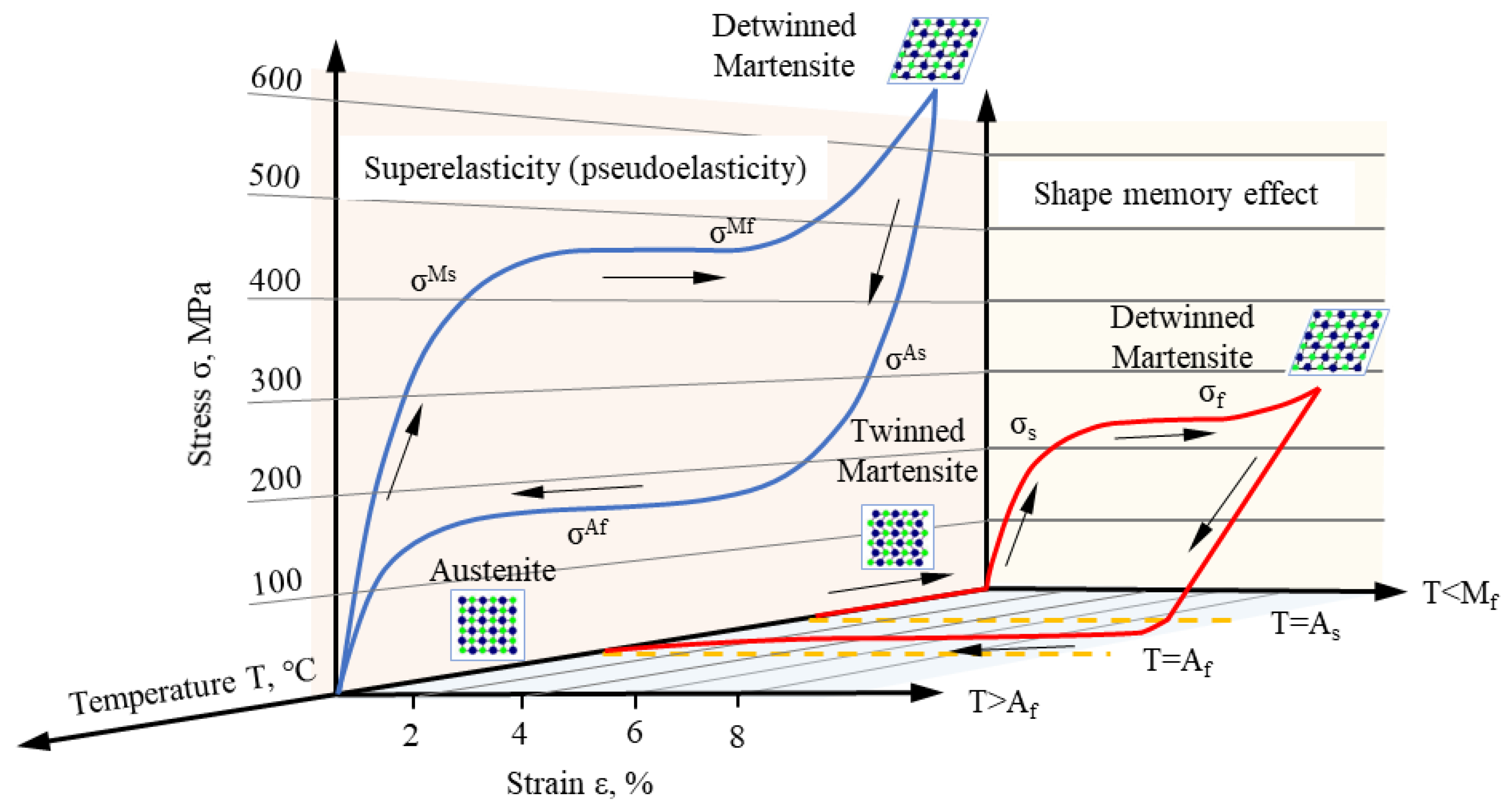

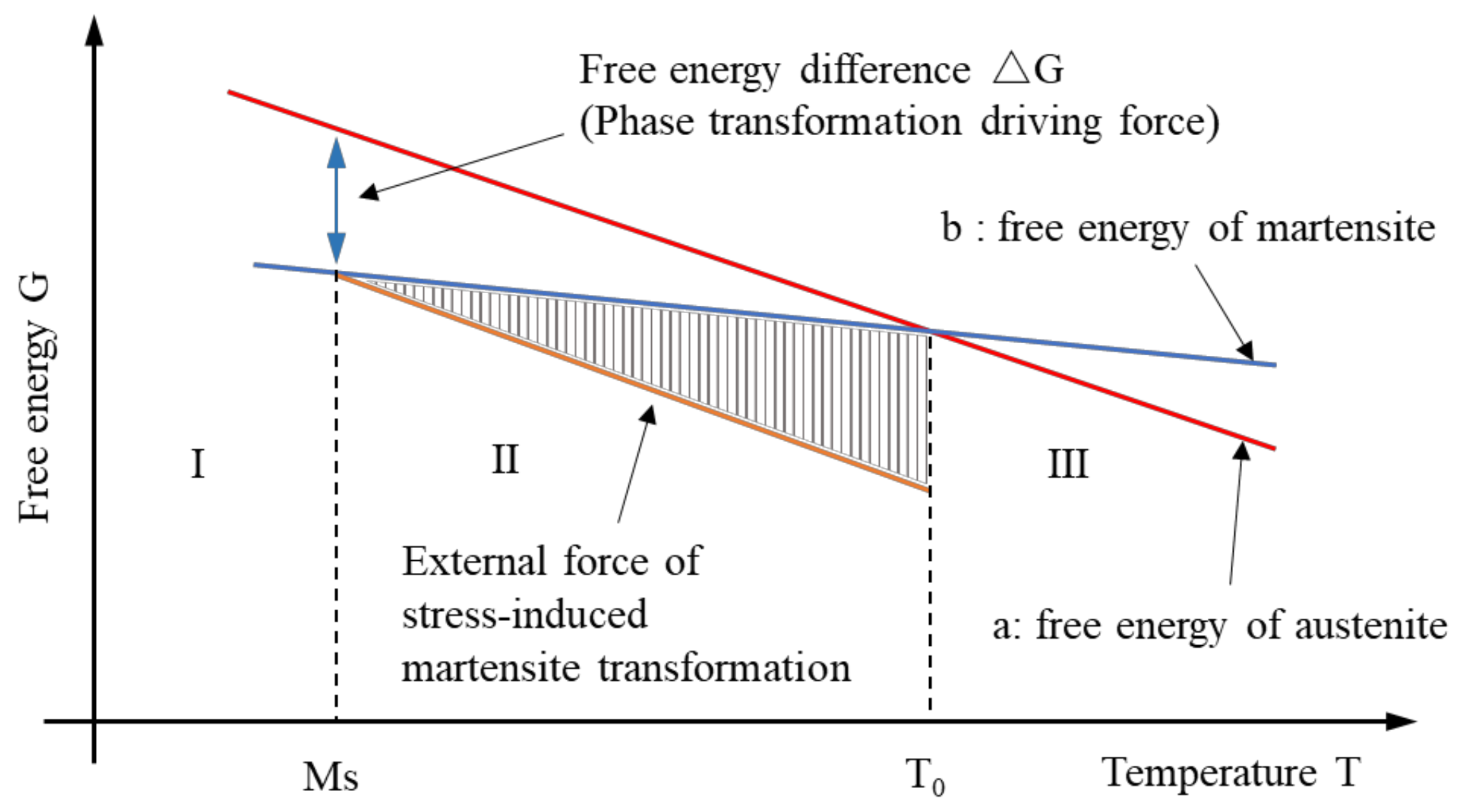
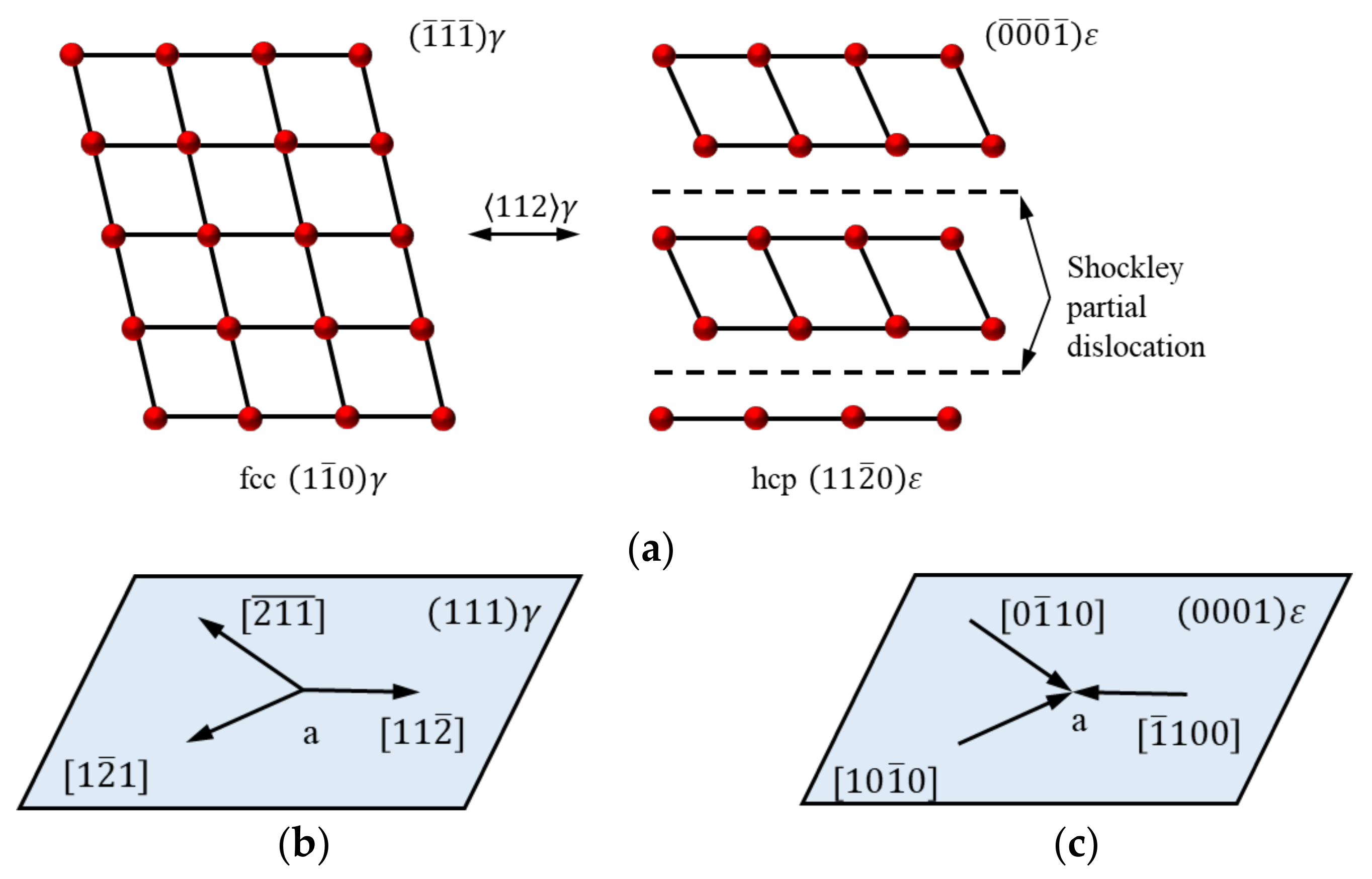
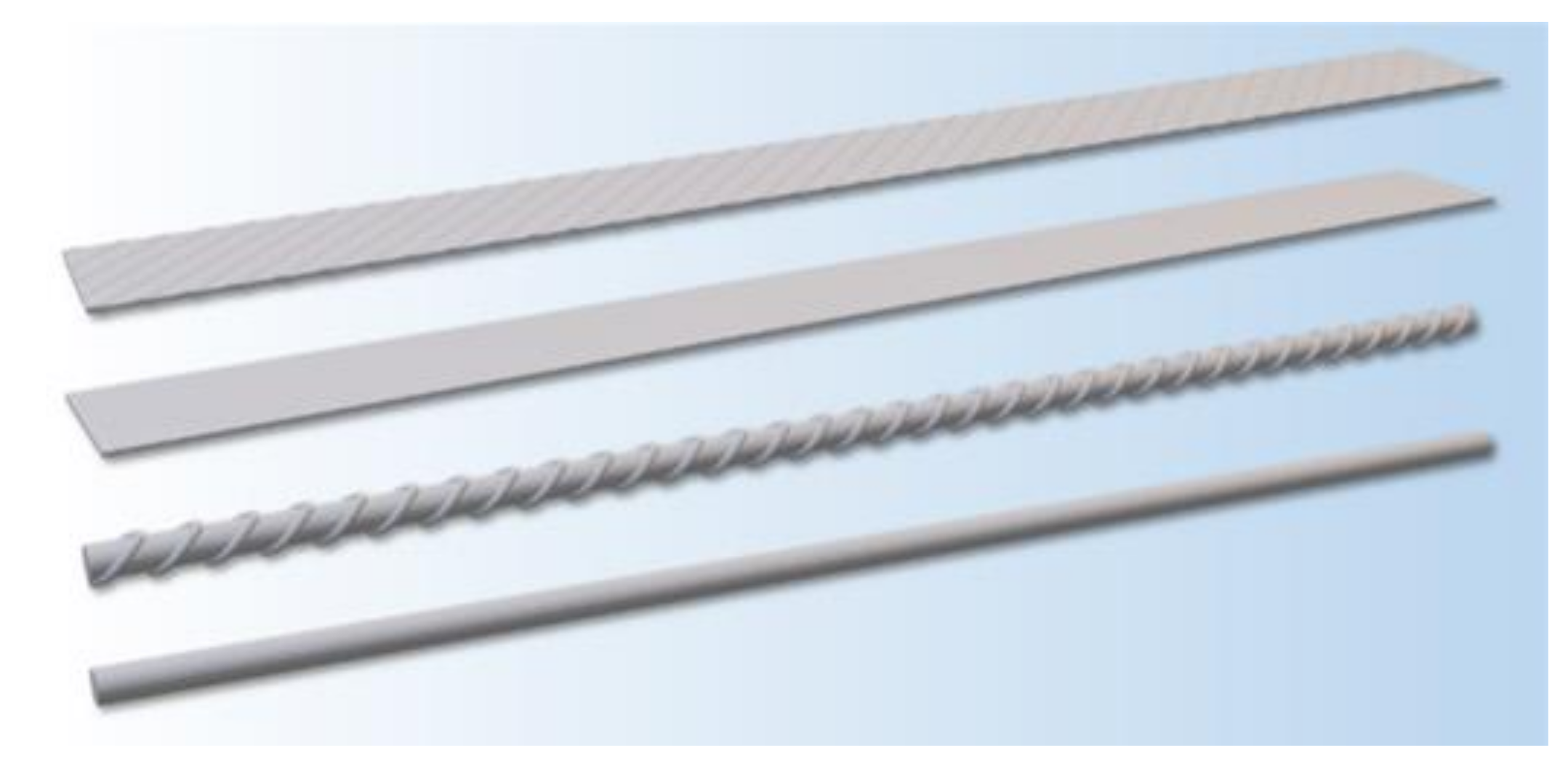
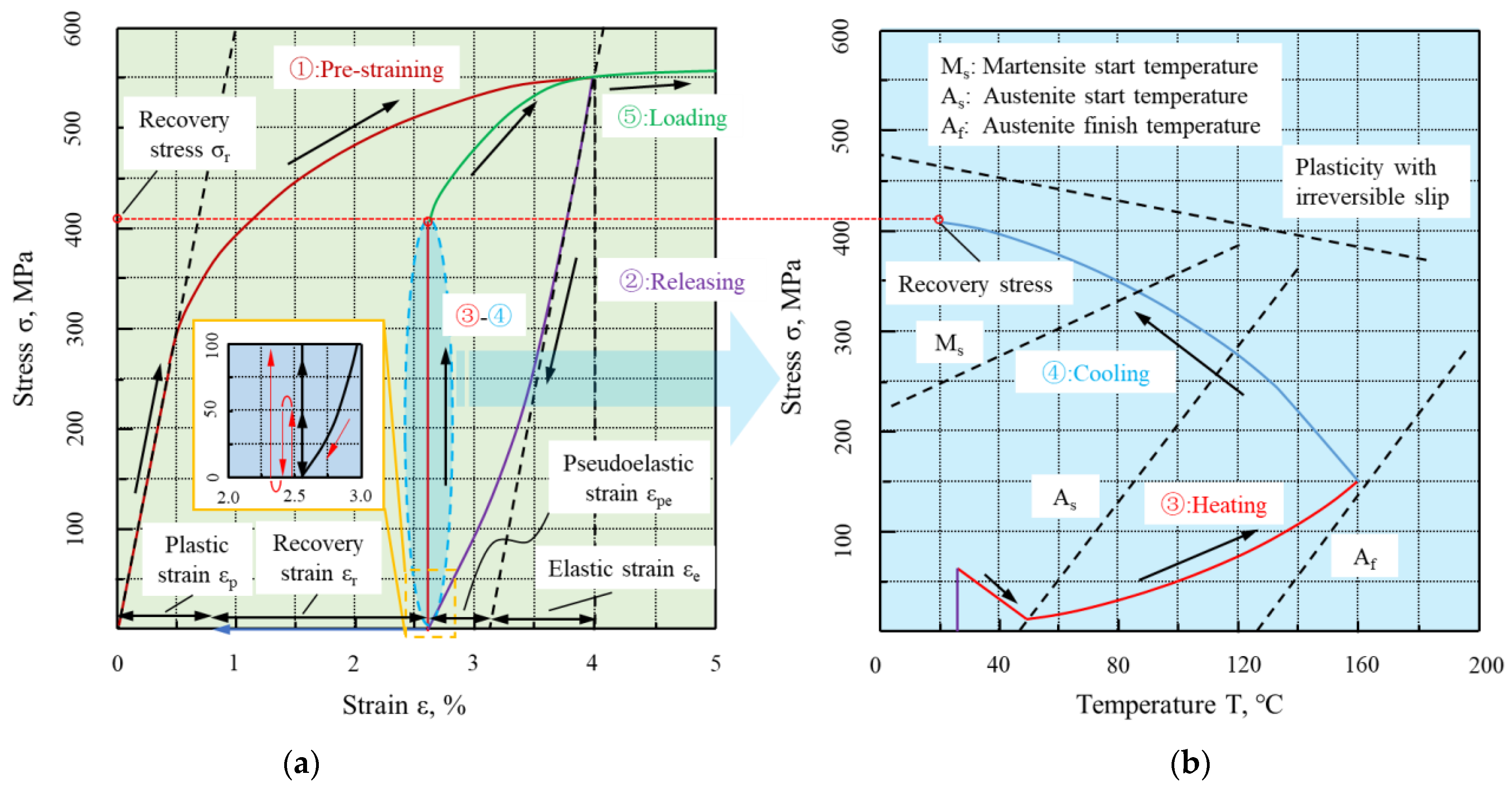
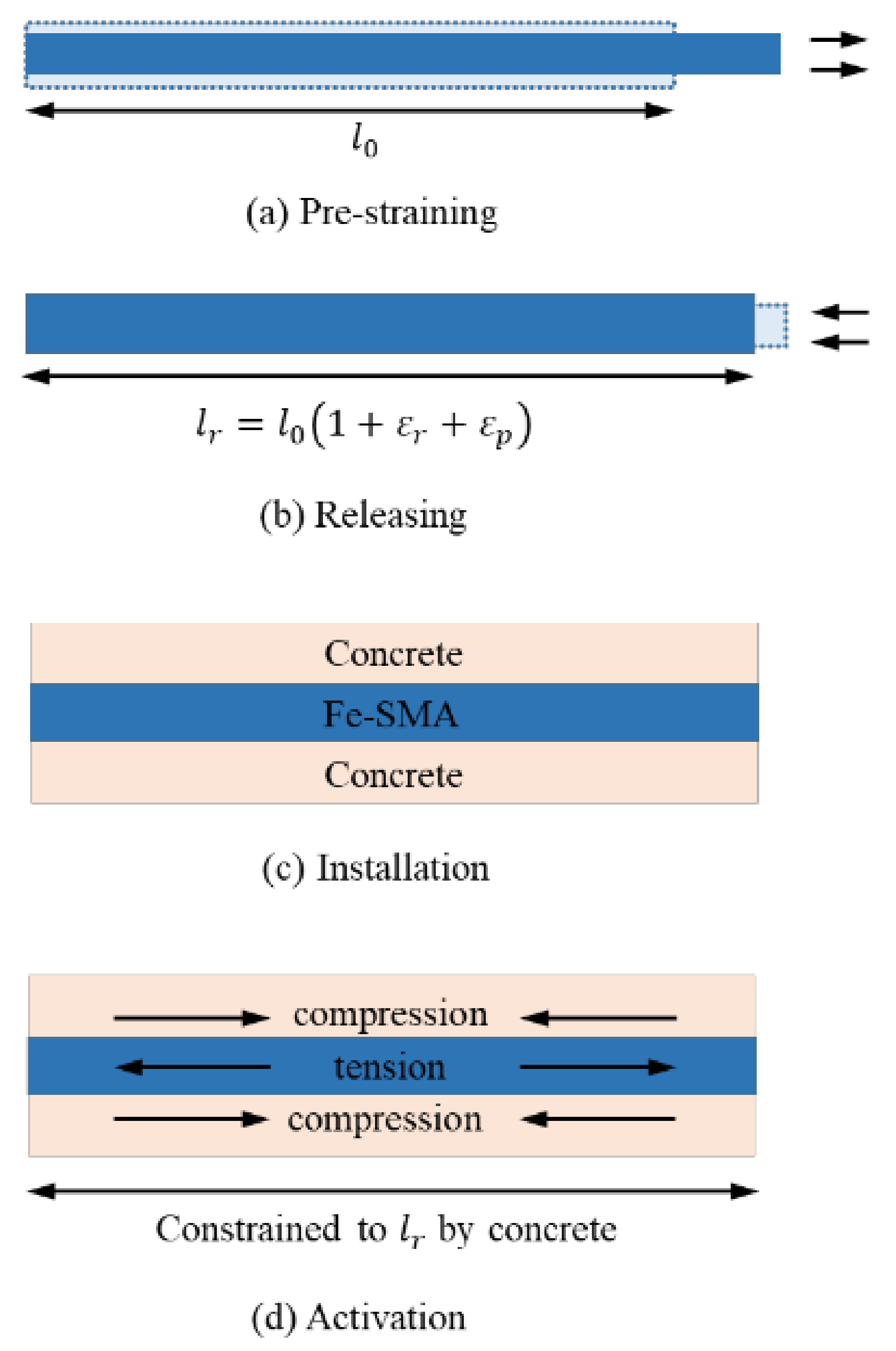
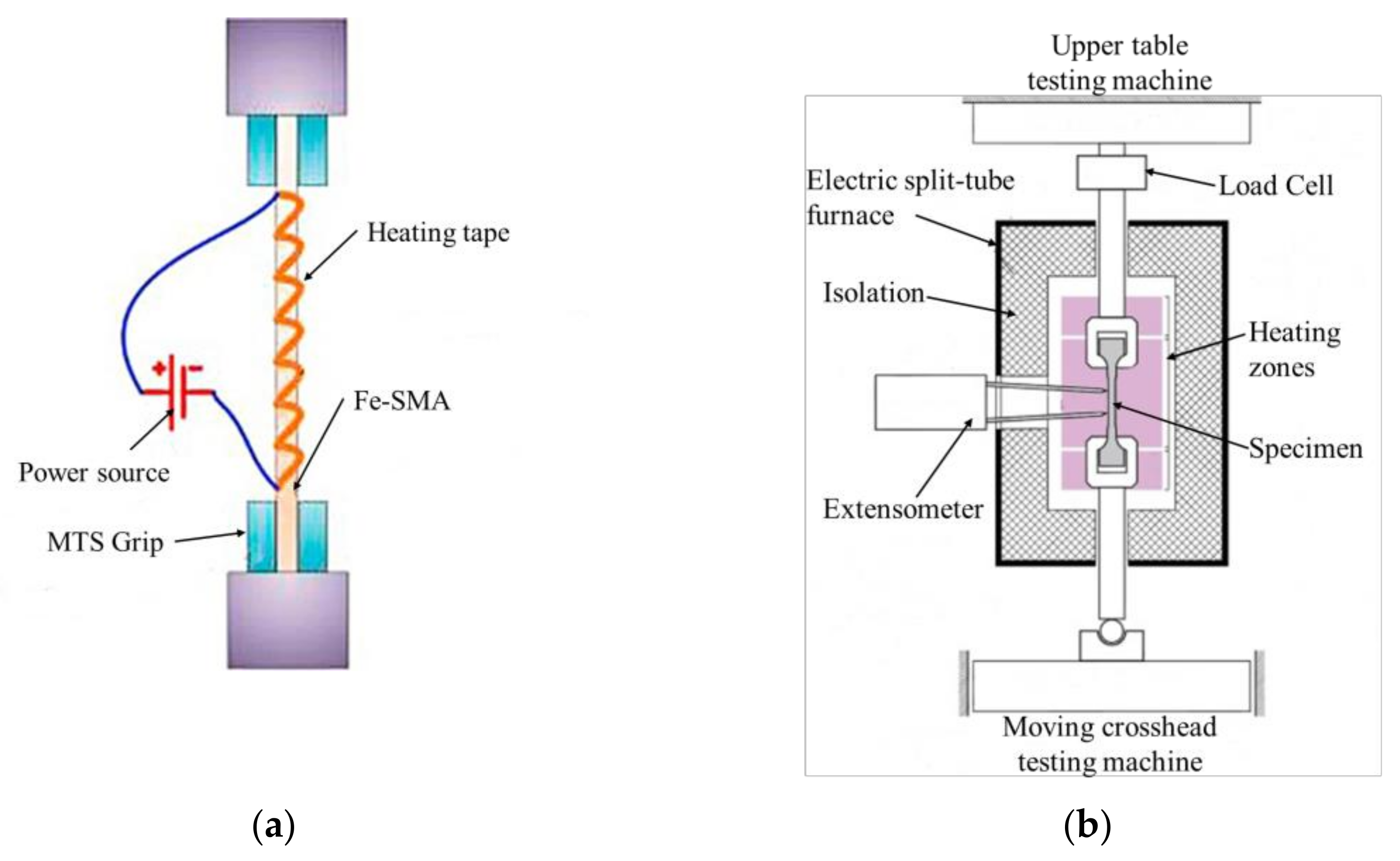
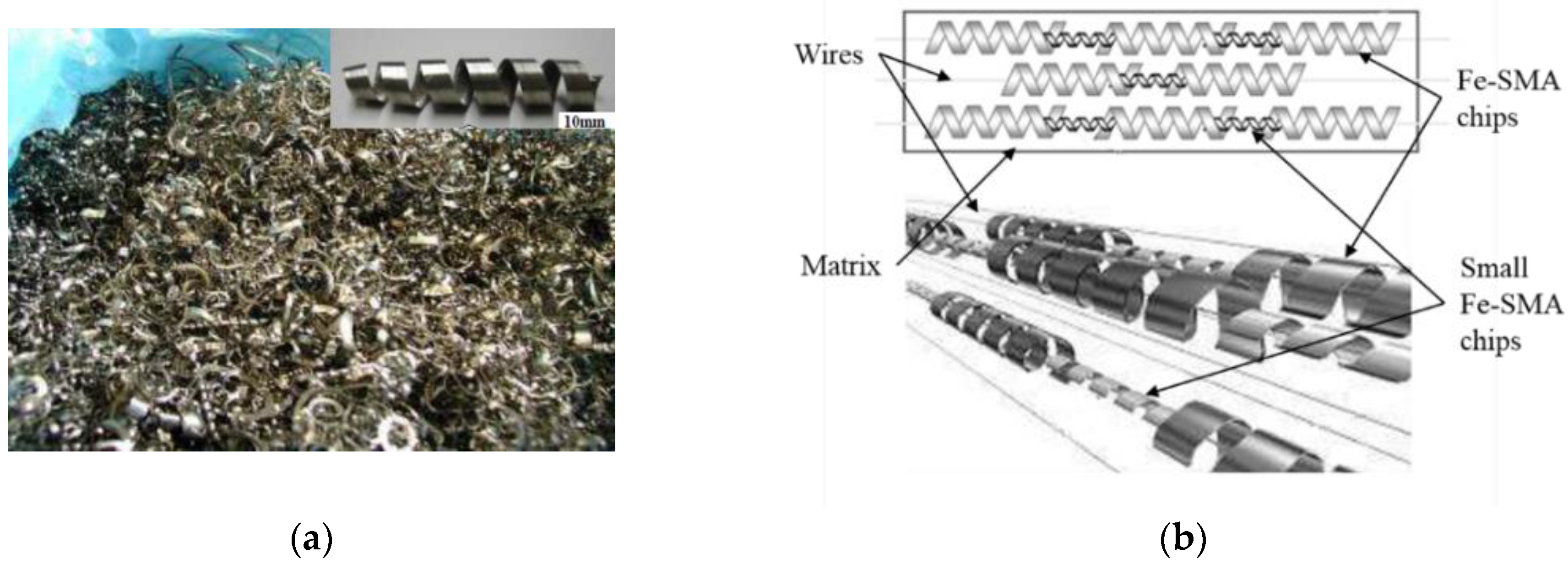
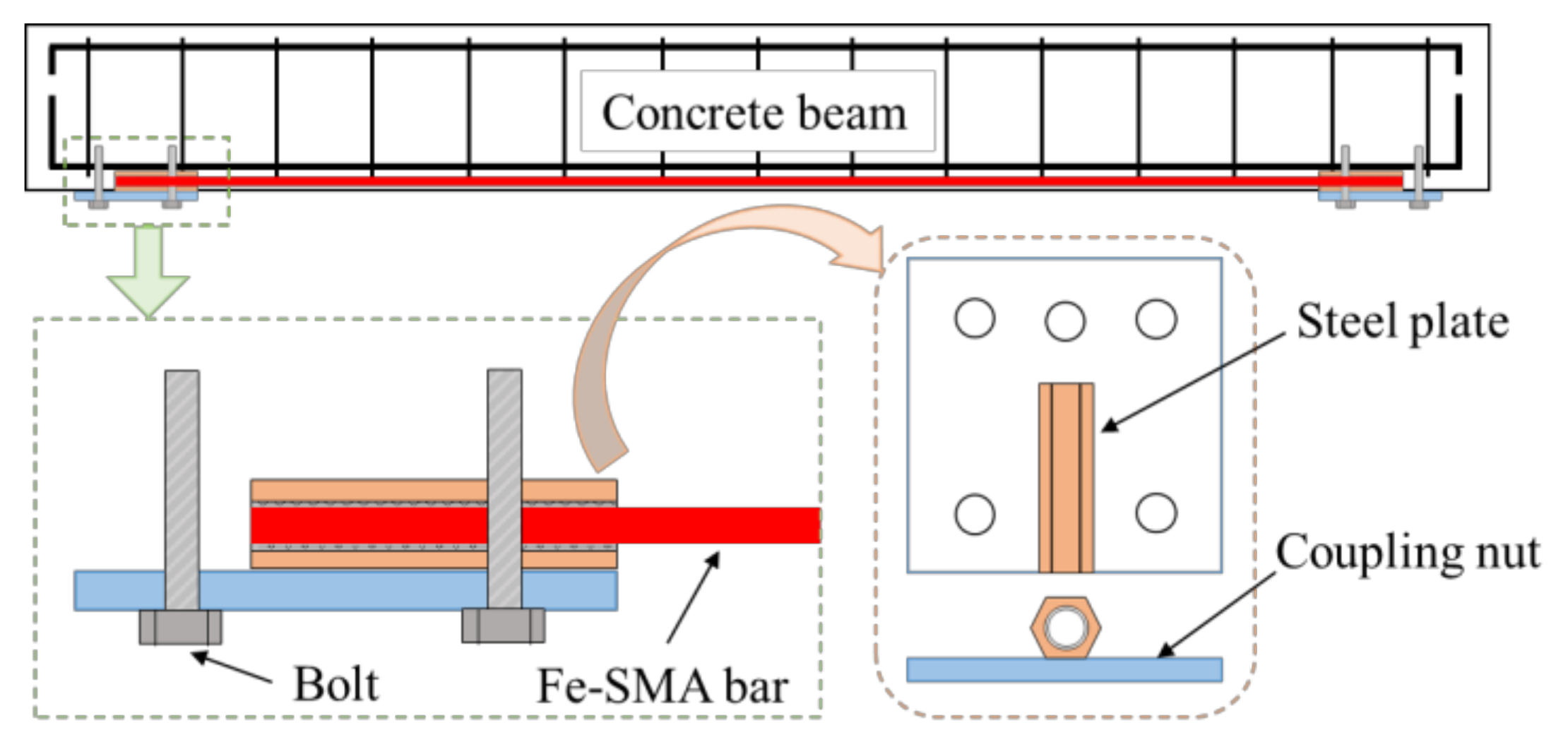

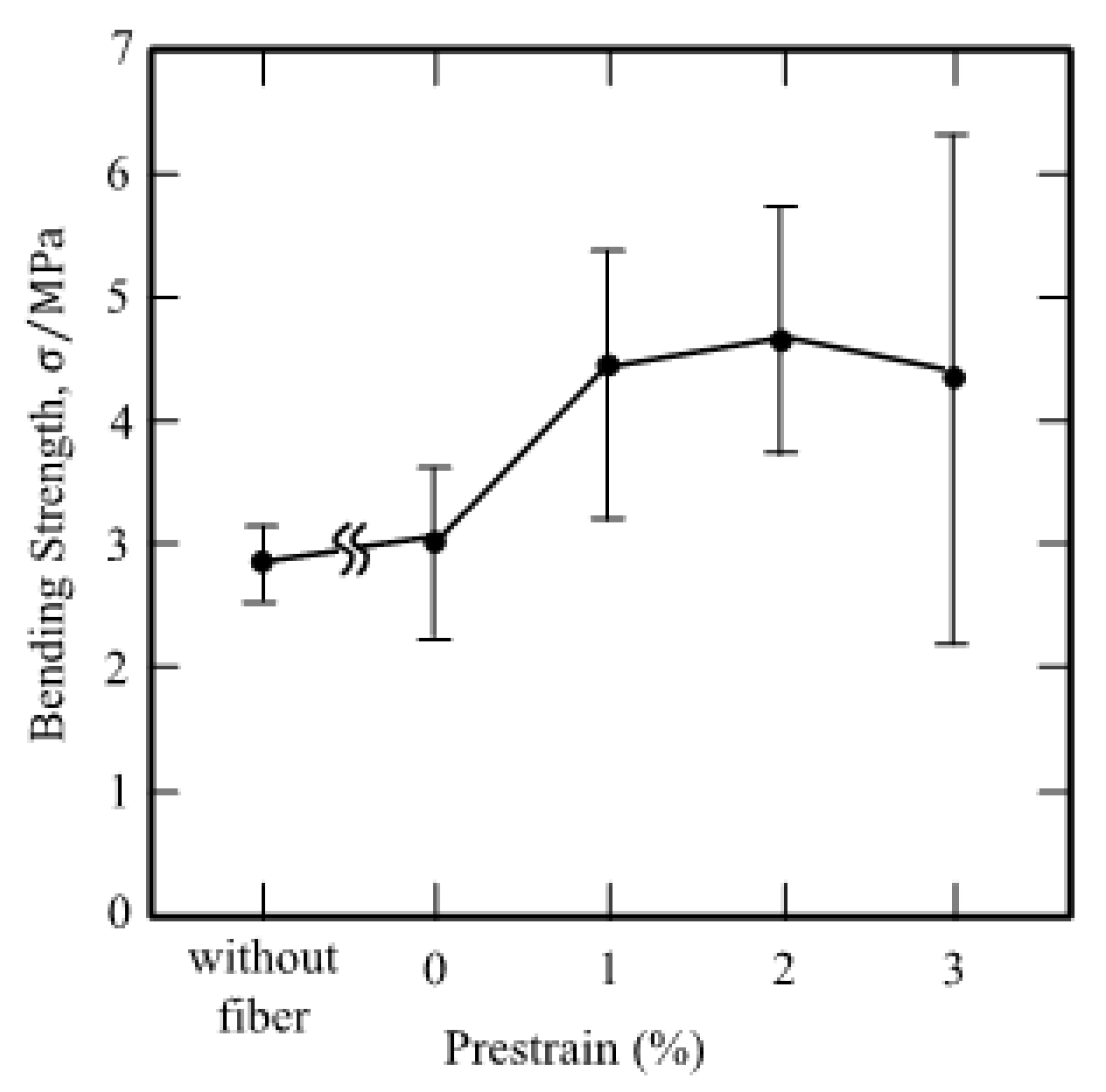
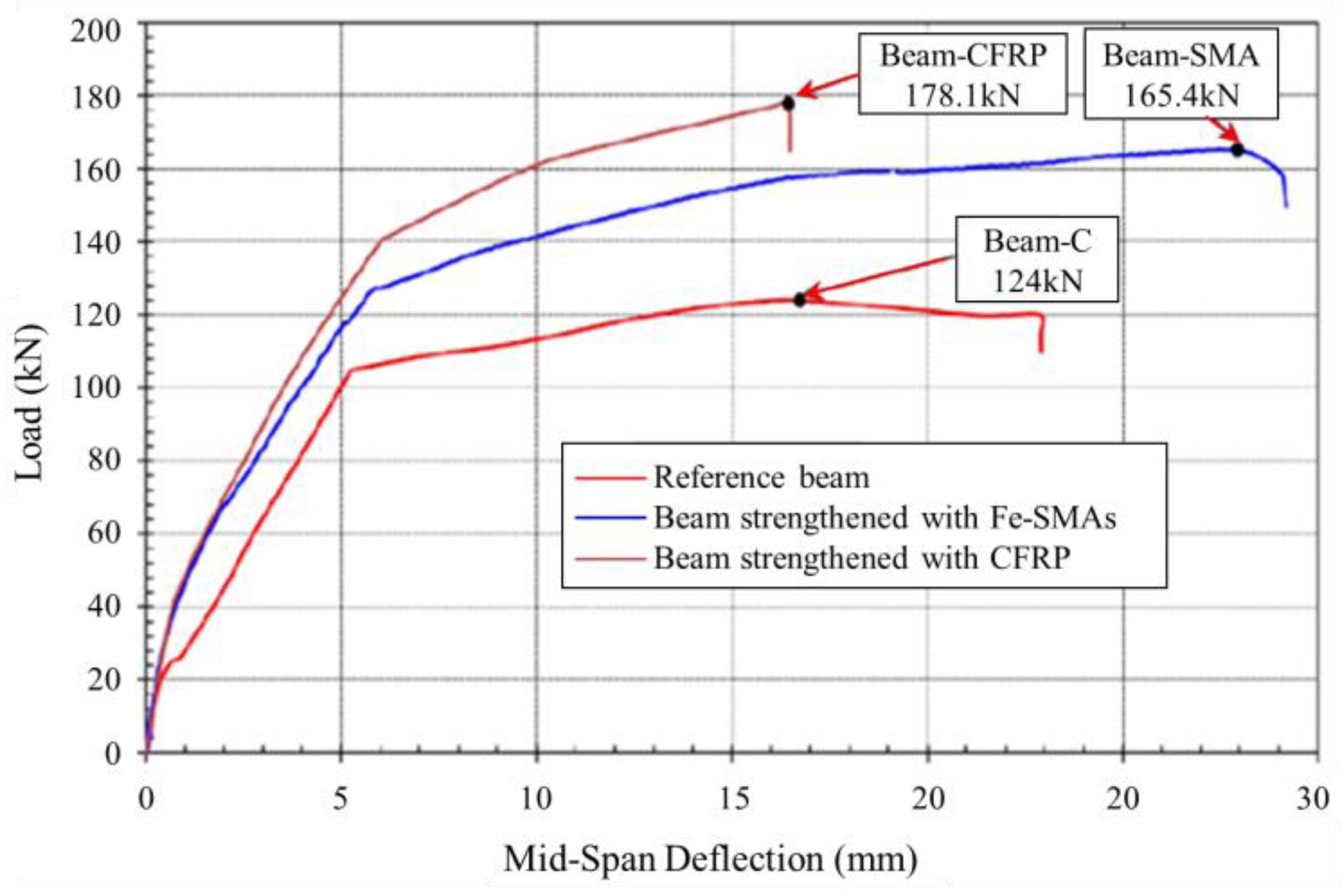
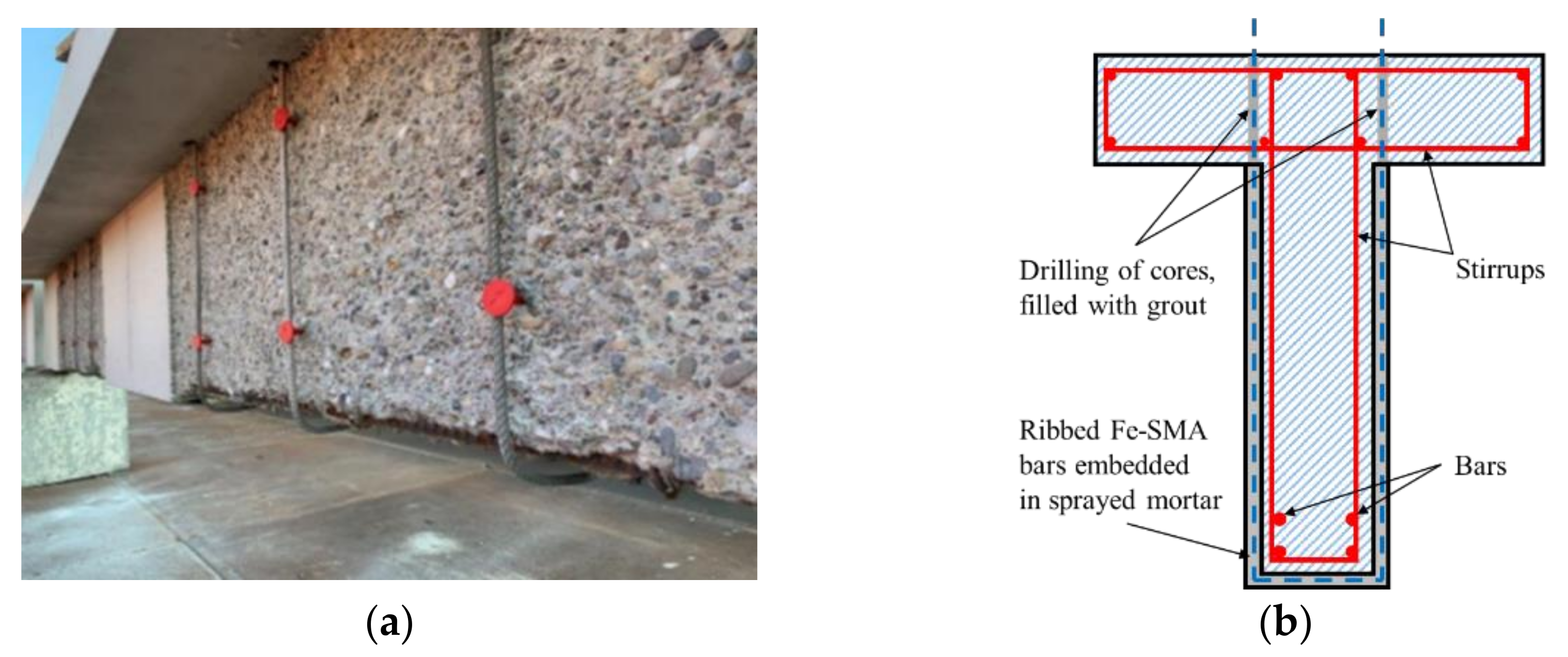

| Alloys | Density (kg/m3) | Elongation (%) | Yield Strength (MPa) | Tensile Strength (MPa) | Thermal Hysteresis (°C) | Recovery Stress (MPa) |
|---|---|---|---|---|---|---|
| Ni-Ti | 6400~6500 | 20~60 | 49.03~196.1 | 686.5~1078.7 | 2~30 | 300 |
| Fe-32%Mn-6%Si | 7200 | 28 | 330 | 700 | 100 | 200~300 |
| Fe-28%Mn-6%Si-5%Cr | 7200 | 35 | 320 | 1000 | 100 | 180~200 |
| Martensite Lattice | Alloys (in Mass %) | Matensite Crystal Struture | Phase Transformation Characteristics | Ms/°C | As/°C | Af/°C | Thermal Hysteresis/°C | Recovery Strain/% |
|---|---|---|---|---|---|---|---|---|
| fct | Fe-25Pt (at.%) [41] | Thin plate | Thermoelastic | - | - | 27 | - | 40~80 |
| Fe-30Pd (at.%) [41] | Thin plate | Thermoelastic | −94 | - | −90 | 4 | 40~80 | |
| bcc (α) or bct (α’) | Fe-25Pt (at.%) (Orderly γ) | Thin plate | Thermoelastic | −142 | - | −125 | 17 | 40~60 |
| Fe-23Ni-10Co-10Ti | - | - | −100 | −30 | ~170 | ~270 | 40~100 | |
| Fe-33Ni-10Co-4Ti | Thin plate | Thermoelastic | −127 | −151 | −54 | 73 | 40~100 | |
| Fe-31Ni-10Co-3Ti | Thin plate | Non-thermoelastic | −80 | 70 | 235 | 315 | 40~100 | |
| Fe-33Ni-10Co-3Ti-1.5Al | Thin plate | Thermoelastic | −118 | −147 | −69 | 49 | - | |
| Fe-28Ni-17Co-11.5Al-2.5Ta-0.05B [60] | - | Thermoelastic | −86 | - | −62 | 24 | - | |
| Fe-31Ni-0.4C | Thin plate | Non-thermoelastic | <−196 | - | ~127 | ~323 | 50~85 | |
| Fe-31Ni-7Nb | - | Non-thermoelastic | −113 | - | - | - | - | |
| Fe-34Mn-15Al-7.5Ni [61] | - | Thermoelastic | −6 | - | - | - | - | |
| hcp | Fe-18.5Mn [62] | Thin plate | Non-thermoelastic | 57 | - | - | - | - |
| Fe-30Mn-1Si (single crystal) [30] | Thin plate | Non-thermoelastic | ~27 | ~127 | - | - | 30~100 | |
| Fe-28Mn-6Si | Thin plate | Non-thermoelastic | 70 | 140 | ~337 | ~267 | - | |
| Fe-(28~33)Mn-(4~6)Si | Thin plate | Non-thermoelastic | ~47 | ~117 | ~177 | ~130 | - | |
| Fe-17Mn-6Si-0.3C | - | Non-thermoelastic | 50 | 180 | 221 | 171 | - | |
| Fe-14Mn-6Si-9Cr-5Ni | Thin plate | Non-thermoelastic | ~20 | ~70 | ~300 | ~280 | 30~100 | |
| Fe-20Mn-5Si-12Cr-5Ni | Thin plate | Non-thermoelastic | −6 | ~109 | <300 | ~306 | - | |
| Fe-8Mn-6Si-13Cr-6Ni-12Co | Thin plate | Non-thermoelastic | −13 | ~97 | <300 | ~313 | - | |
| Fe-19Mn-4Si-8Cr-4Ni-0.01C (at.%) [63] | - | Non-thermoelastic | −38 | 138 | 218 | 256 | - |
| Alloys | Year | Ref. |
|---|---|---|
| Fe-30%Mn-1%Si (single crystal) | 1982 | [30] |
| Fe-30%Mn-6%Si (single crystal) | 1984 | [44] |
| Fe-32%Mn-6%Si | 1986 | [87] |
| Fe-28%Mn-6%Si-5%Cr | 1990 | [81] |
| Fe-20%Mn-5%Si-8%Cr-5%Ni | ||
| Fe-16%Mn-5%Si-12%Cr-5%Ni | ||
| Fe-28%Mn-6%Si-5%Cr-0.5% (Nb, C) | 2001 | [43] |
| Fe-18%Mn-8%Cr-4%Si-2%Ni-0.36%Nb-0.36%N | 2001 | [32] |
| Fe-28%Mn-6%Si-5%Cr | ||
| Fe-28%Mn-6%Si-5%Cr-1% (V, N) | 2004 | [88] |
| Fe-15%Mn-5%Si-9%Cr-5%Ni-(0.5–1.5)%NbC | 2005 | [89] |
| Fe-28%Mn-6%Si-5%Cr-0.53%Nb-0.06%C | 2006 | [90] |
| Fe-14%Mn-5%Si-8%Cr-4%Ni-0.16%C | 2007 | [88] |
| Fe-17%Mn-5%Si-10%Cr-4%Ni-1% (V, C) | 2009 | [82] |
| Fe-16%Mn-5%Si-10%Cr-4%Ni-1% (V, N) | 2013 | [89] |
| Fe-19%Mn-4%Si-8%Cr-4%Ni-0.01%C | 2021 | [63] |
| Alloys | Specimens | Pre-Strain/% | Activation Modes | Control Details | Activation Temperature/°C | Recovery Stress/MPa |
|---|---|---|---|---|---|---|
| Fe-17Mn-5Si-10Cr-4Ni-1 (V, C) (in mass %) | strips [95] | 4 | climate chamber | 2 °C/min | 160 | ~328.85 |
| strips [2] | 4 | climate chamber | 2 °C/min | 160 | 266 | |
| dog-bone shaped specimens [100] | 4 | climate chamber | 2 °C/min | 140 | 130 | |
| 160 | 400 | |||||
| strips [98] | 2 | electric resistance | 2 A/mm2 | 160 | 308 | |
| 4 | 160 | 348 | ||||
| bars [99] | 4 | electric resistance | 7.6 A/mm2 | ~160 | 285~307 | |
| ribbed strips [101] | 2 | electric resistance | 7.65~8.82 A/mm2 | 160 | 190~213 | |
| ~160 | 342 | |||||
| strips [6] | 2 | climate chamber | 2 °C/min | 160 | 342 | |
| resistive heating | 125 A/380 V | 180 | 380 | |||
| ribbed strips [102] | 4 | climate chamber | 2 °C/min | 160 | 250 | |
| 160 | 350 | |||||
| ribbed bars [108] | ~4 | cooper clamps | 3.5 A/mm2 | 160 | ~300 | |
| dog-bone-shaped specimens [109] | 2 | Inductive heating coil | 2 °C/min | 160 | 372 | |
| strips [110] | 2 | split-tube electric furnace | 5, 15, 50 °C/min | 160 | 358.6~377.9 | |
| dog-bone shaped specimens [92] | 4 | climate chamber | 0.1 °C/s | 160~225 | ~500 | |
| dog-bone shaped specimens [82] | 4 | climate chamber | 0.1 °C/s | 225 | 380 | |
| Fe-28Mn-6Si-5Cr-0.53Nb-0.06C (in mass %) | strips [99] | 5 | infrared furnace | - | 397 | 250 |
| Fe-19Mn-4Si-8Cr-4Ni-0.01C (at.%) | wires [63] | 5 | Hot gun | - | 200 | 245 |
| 5 | 250 | 280 | ||||
| 5 | 300 | 315 | ||||
| 4 | 250 | 268 | ||||
| 6 | 250 | 219 | ||||
| Fe-Mn-Si produced by AWAJI | bars [105] | 6 | flexible heating tapes | - | 350 | 215~160 |
| bars [103] | 6 | heating tape | - | 350 | ~200 | |
| bars [104] | 6 | flexible heating tapes | - | 315 | 130 |
Publisher’s Note: MDPI stays neutral with regard to jurisdictional claims in published maps and institutional affiliations. |
© 2022 by the authors. Licensee MDPI, Basel, Switzerland. This article is an open access article distributed under the terms and conditions of the Creative Commons Attribution (CC BY) license (https://creativecommons.org/licenses/by/4.0/).
Share and Cite
Qiang, X.; Chen, L.; Jiang, X. Achievements and Perspectives on Fe-Based Shape Memory Alloys for Rehabilitation of Reinforced Concrete Bridges: An Overview. Materials 2022, 15, 8089. https://doi.org/10.3390/ma15228089
Qiang X, Chen L, Jiang X. Achievements and Perspectives on Fe-Based Shape Memory Alloys for Rehabilitation of Reinforced Concrete Bridges: An Overview. Materials. 2022; 15(22):8089. https://doi.org/10.3390/ma15228089
Chicago/Turabian StyleQiang, Xuhong, Longlong Chen, and Xu Jiang. 2022. "Achievements and Perspectives on Fe-Based Shape Memory Alloys for Rehabilitation of Reinforced Concrete Bridges: An Overview" Materials 15, no. 22: 8089. https://doi.org/10.3390/ma15228089
APA StyleQiang, X., Chen, L., & Jiang, X. (2022). Achievements and Perspectives on Fe-Based Shape Memory Alloys for Rehabilitation of Reinforced Concrete Bridges: An Overview. Materials, 15(22), 8089. https://doi.org/10.3390/ma15228089











